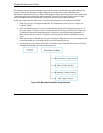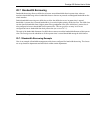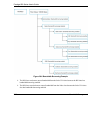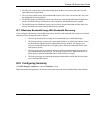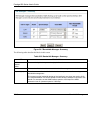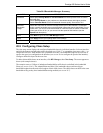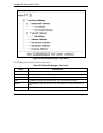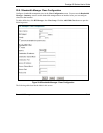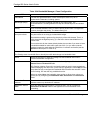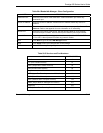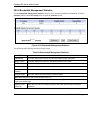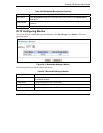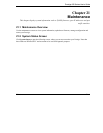
Prestige 650 Series User’s Guide
20-14 Bandwidth Management
Table 20-4 Bandwidth Manager: Class Configuration
LABEL DESCRIPTION
Class Name Use the auto-generated name or enter a descriptive name of up to 20
alphanumeric characters, including spaces.
BW Budget (kbps) Specify the maximum bandwidth allowed for the class in kbps. The
recommendation is a setting between 20 kbps and 20000 kbps for an individual
class.
Priority Enter a number between 0 and 7 to set the priority of this class. The higher the
number, the higher the priority. The default setting is 3.
Borrow bandwidth
from parent class
Select this option to allow a child-class to borrow bandwidth from its parent class if
the parent class is not using up its bandwidth budget.
Bandwidth borrowing is governed by the priority of the child-classes. That is, a
child-class with the highest priority (7) is the first to borrow bandwidth from its
parent class.
Do not select this for the classes directly below the root class if you want to leave
bandwidth available for other traffic types (see 20.6.1) or you want to set the
interface’s speed to match what the next device in network can handle (see the
Speed field description in Table 20-2).
Bandwidth Filter
The Prestige uses a bandwidth filter to identify the traffic that belongs to a bandwidth class.
Active Select the check box to have the Prestige use this bandwidth filter when it
performs bandwidth management.
Service
You can select a predefined service instead of configuring the Destination Port,
Source Port and Protocol ID fields.
SIP (Session Initiation Protocol) is a signaling protocol used in Internet telephony,
instant messaging and other VoIP (Voice over IP) applications. Select SIP from the
drop-down list box to configure this bandwidth filter for traffic that uses SIP. At the
time of writing, SIP was the only predefined service.
When you select None, the bandwidth class applies to all services unless you
specify one by configuring the Destination Port, Source Port and Protocol ID
fields.
Destination IP
Address
Enter the destination IP address in dotted decimal notation. A blank destination IP
address means any destination IP address.
Destination Subnet
Mask
Enter the destination subnet mask. This field is N/A if you do not specify a
Destination IP Address. Refer to the appendix for more information on IP
subnetting.



